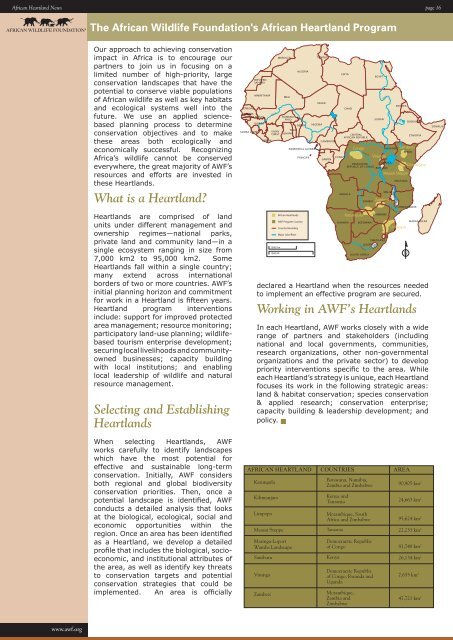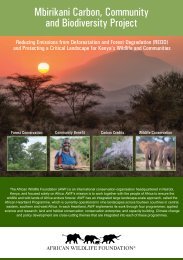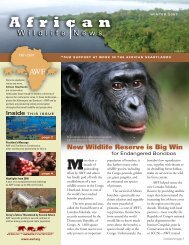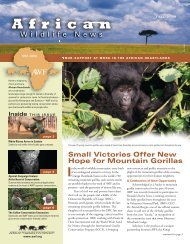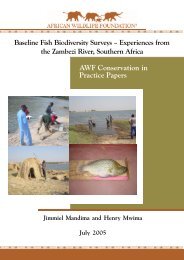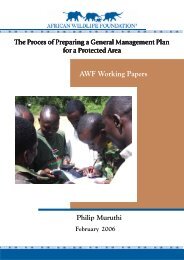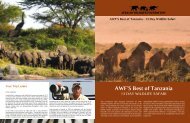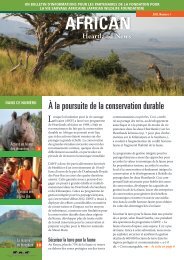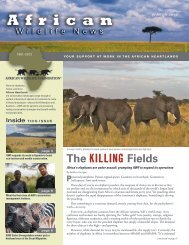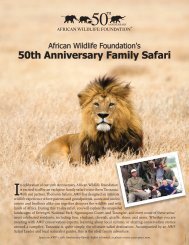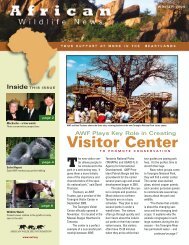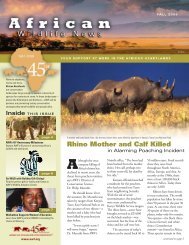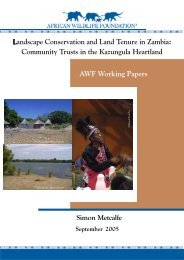Download - African Wildlife Foundation
Download - African Wildlife Foundation
Download - African Wildlife Foundation
You also want an ePaper? Increase the reach of your titles
YUMPU automatically turns print PDFs into web optimized ePapers that Google loves.
<strong>African</strong> Heartland News page 16<br />
<br />
Our approach to achieving conservation<br />
impact in Africa is to encourage our<br />
partners to join us in focusing on a<br />
limited number of high-priority, large<br />
conservation landscapes that have the<br />
potential to conserve viable populations<br />
of <strong>African</strong> wildlife as well as key habitats<br />
and ecological systems well into the<br />
future. We use an applied sciencebased<br />
planning process to determine<br />
conservation objectives and to make<br />
these areas both ecologically and<br />
economically successful.<br />
Recognizing<br />
Africa’s wildlife cannot be conserved<br />
everywhere, the great majority of AWF’s<br />
resources and efforts are invested in<br />
these Heartlands.<br />
What is a Heartland?<br />
Heartlands are comprised of land<br />
units under different management and<br />
ownership regimes—national parks,<br />
private land and community land—in a<br />
single ecosystem ranging in size from<br />
7,000 km2 to 95,000 km2. Some<br />
Heartlands fall within a single country;<br />
many extend across international<br />
borders of two or more countries. AWF’s<br />
initial planning horizon and commitment<br />
for work in a Heartland is fifteen years.<br />
Heartland program interventions<br />
include: support for improved protected<br />
area management; resource monitoring;<br />
participatory land-use planning; wildlifebased<br />
tourism enterprise development;<br />
securing local livelihoods and communityowned<br />
businesses; capacity building<br />
with local institutions; and enabling<br />
local leadership of wildlife and natural<br />
resource management.<br />
Selecting and Establishing<br />
Heartlands<br />
When selecting Heartlands, AWF<br />
works carefully to identify landscapes<br />
which have the most potential for<br />
effective and sustainable long-term<br />
conservation. Initially, AWF considers<br />
both regional and global biodiversity<br />
conservation priorities. Then, once a<br />
potential landscape is identified, AWF<br />
conducts a detailed analysis that looks<br />
at the biological, ecological, social and<br />
economic opportunities within the<br />
region. Once an area has been identified<br />
as a Heartland, we develop a detailed<br />
profile that includes the biological, socioeconomic,<br />
and institutional attributes of<br />
the area, as well as identify key threats<br />
to conservation targets and potential<br />
conservation strategies that could be<br />
implemented. An area is officially<br />
declared a Heartland when the resources needed<br />
to implement an effective program are secured.<br />
Working in AWF’s Heartlands<br />
In each Heartland, AWF works closely with a wide<br />
range of partners and stakeholders (including<br />
national and local governments, communities,<br />
research organizations, other non-governmental<br />
organizations and the private sector) to develop<br />
priority interventions specific to the area. While<br />
each Heartland’s strategy is unique, each Heartland<br />
focuses its work in the following strategic areas:<br />
land & habitat conservation; species conservation<br />
& applied research; conservation enterprise;<br />
capacity building & leadership development; and<br />
policy.<br />
AFRICAN HEARTLAND COUNTRIES AREA<br />
Kazungula<br />
Kilimanjaro<br />
Limpopo<br />
Maasai Steppe<br />
Maringa-Lopori<br />
Wamba Landscape<br />
Samburu<br />
Virunga<br />
Zambezi<br />
Botswana, Namibia,<br />
Zambia and Zimbabwe<br />
Kenya and<br />
Tanzania<br />
Mozambique, South<br />
Africa and Zimbabwe<br />
Tanzania<br />
Democractic Republic<br />
of Congo<br />
Kenya<br />
Democractic Republic<br />
of Congo, Rwanda and<br />
Uganda<br />
Mozambique,<br />
Zambia and<br />
Zimbabwe<br />
90,905 km 2<br />
24,663 km 2<br />
95,624 km 2<br />
22,233 km 2<br />
81,748 km 2<br />
26,134 km 2<br />
7,655 km 2<br />
47,721 km 2<br />
www.awf.org


